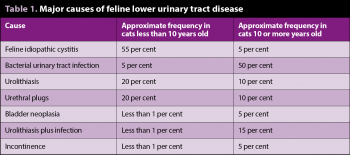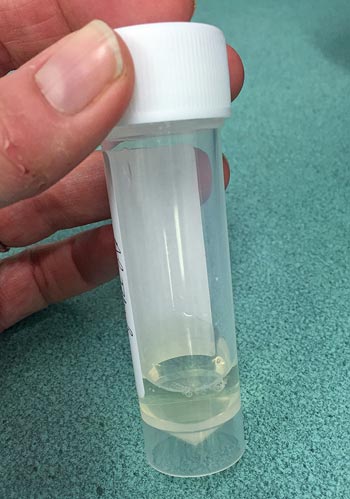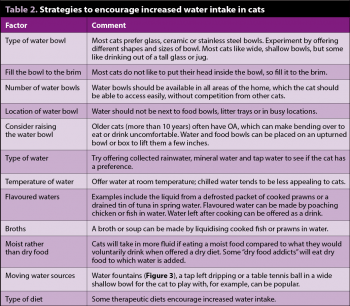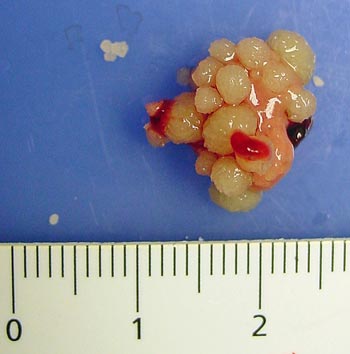10 Jul 2017
Approaches to feline cystitis
Sarah Caney looks at causes, management and treatment of urinary tract disease in cats, including diet and nutraceuticals.

Figure 3. Some cats will drink more if offered a moving water source, such as this fountain.
FLUTD is a term used to encompass a number of conditions that affect the bladder and urethra.

It typically affects 1% of cats and is characterised by clinical signs of cystitis. It is most common in young and middle-aged cats. Several important medical causes of FLUTD exist, but idiopathic FLUTD – also known as feline idiopathic cystitis (FIC) – is the most common by far.
FLUTD is subdivided into obstructive and non-obstructive disease. Cats with obstructive disease are unable to pass urine – often referred to as blocked cats. Urethral obstruction is a veterinary emergency and cats with this condition may die within two to three days if not treated.
Cats with non-obstructive disease are able to pass urine and typically strain to pass small amounts on a frequent basis. The urine may appear abnormal (such as bloody). Cats may show signs of pain when straining and periuria may be present due to the urgency to urinate.
Several important causes of FLUTD are known and are listed in Table 1.
Diagnosing the cause of FLUTD is especially important in cats that show repeated episodes or where the clinical signs are persistent. Diagnosis of FLUTD may require a full behavioural and clinical history, physical examination, blood and urinalysis, imaging and possibly biopsy of the urinary tract.
Optimal treatment of FLUTD depends on making an accurate diagnosis. The treatment will vary according to the cause of the FLUTD – for example, some bladder stones (for example, struvite) can be “dissolved” using a specially designed therapeutic diet, whereas other bladder stones (such as oxalate) cannot be dissolved and, therefore, may need to be surgically removed.
FIC
FIC remains the most common cause of FLUTD and accounts for more than half of all FLUTD cases. Research has highlighted the role stress plays in triggering and exacerbating FIC. In the long term, the best results are achieved by adopting a dual approach to reduce stress and encourage the cat to produce dilute urine.
Strategies to reduce stress at home

Efforts should be focused on identifying and addressing potential causes of stress in the home. For example, these may include conflict between the cat with FIC and other cats in the home or neighbourhood, the addition of new pets or people into the home, sudden changes of routine and so on. In severe cases, referral to a veterinary behavioural expert may be valuable to accurately diagnose and resolve causes of chronic stress.
Conflict between cats is a common cause of stress. To address this, care needs to be taken to understand the number of social groups within the home and determine whether adequate resources are available for each social group. Each social group needs access to litter boxes or other toileting facilities, food, water, somewhere to rest/hide, and safe entry and exit routes. Several social groups may exist in the home and each of these needs its own separate resources.
Synthetic pheromone preparations, such as facial pheromone and cat appeasing pheromone, can also be helpful in some FIC cases. The synthetic facial pheromone acts as a confirmatory signal the environment is safe and, therefore, must be used in conjunction with other environmental management, such as ensuring adequate litter boxes are placed and so on. The synthetic cat appeasing pheromone is referred to as the harmony marker and has been proven to decrease the frequency and intensity of conflict and tension in multicat households (DePorter et al, 2014). Both pheromone products can be used simultaneously or individually, according to the situation.
Nutraceuticals can be employed as an adjunctive management option to help alleviate stress. Alpha-casozepine is a milk protein hydrolysate thought to interact with the gamma-aminobutyric acid A receptor and result in anxiolytic effects. A small double-blinded, placebo-controlled study using this product in cats identified to be suffering from anxiety showed beneficial effects in many of the cats receiving this dietary supplement (Beata et al, 2007).
The nutraceutical tryptophan is an essential amino acid and precursor for serotonin synthesis. Serotonin is an important neurotransmitter involved in mood control and believed to contribute to feelings of well-being. A placebo-controlled study showed supplementation of L-tryptophan resulted in a reduction in stress-associated behaviours, such as house soiling (Da Graca Pereira et al, 2010). Nutraceuticals can be supplied as supplements, but are also contained in some therapeutic foods. A small case series reported an improvement in signs of FIC and anxiety-related behaviour in cats receiving a diet designed for cats with FLUTD and supplemented in alpha-casozepine and L-tryptophan (Meyer and Becvárová, 2016).
Glycosaminoglycan (GAG) supplements are available in some nutraceutical products. GAG supplements are believed to work by attaching to the bladder lining and reduce its permeability to noxious substances. Unfortunately, several clinical studies have shown GAG supplements are not generally effective in the majority of cats affected by FIC (Gunn-Moore and Shenoy, 2004; Chew et al, 2009).
Environmental enrichment is beneficial as a means of reducing stress. Examples of positive ways of improving a cat’s environment include the provision of climbing frames with resting areas and playing games that stimulate natural cat behaviour. Restricting (or reducing) the number of cats in the home to socially compatible levels and resisting the temptation to expand the household by introducing new cats will help reduce the incidence of stress-related diseases, such as FIC.
Encouraging less concentrated urine

The production of more dilute (watery) urine is helpful for many causes of FLUTD including FIC. The aim is for the cat to produce urine with a urine specific gravity around 1.035 (Figure 1). This encourages frequent urination and dilutes any irritant components of the urine. Producing dilute urine does not treat the underlying cause of FIC, so issues such as stress also need to be addressed. Where possible, moist food should be offered. Tips for encouraging drinking are summarised in Table 2.
Other treatments
A significant reduction in the recurrence of clinical signs in cats diagnosed with acute FIC was reported in a dietary study (Kruger et al, 2015). In this prospective, randomised, double-blinded study, the owners were able to choose whether to feed wet or dry food. The test food comprised a commercially available diet and the control food was a custom-formulated food designed to mimic typical supermarket brands. Both dry and wet formulations of the test diet reduced the rate of recurrent episodes of FIC signs by 89%, although a previous study indicated feeding a wet food was more successful for the management of FIC (Markwell et al, 1999).
Obesity management is indicated, where appropriate. Medical treatments may be suggested in cats with FIC, depending on the individual situation – these include painkillers, anxiolytics and antispasmodics.
Urolithiasis
Nutritional dissolution is well-established as a treatment for struvite urolithiasis. A randomised, controlled, double-blinded clinical trial has advanced our knowledge by evaluating the efficacy of two commercially available dry foods for struvite stone dissolution (Lulich et al, 2013). The test diets were a dissolution formula and a preventive/maintenance food for cats with FLUTD. The cats were monitored via weekly abdominal radiography. Both diets were 100% effective in dissolving struvite stones, although the rate of dissolution differed. The mean time to dissolution was 27 days for cats receiving the preventive/maintenance food versus 13 days for cats receiving the dissolution formula.
The authors reported the calculation of per cent dissolution at two weeks was helpful since all struvite stones had decreased in size by 35% to 100% for both diets. Minimal or no stone reduction at two weeks would be consistent with a different form of urolith, such as calcium oxalate. Although dissolution is slower with the maintenance food, it has the advantage of being a suitable long-term food that can be fed to all healthy cats in the household. Compliance to the foods was high, with all of the cats reportedly accepting a sudden change in their diet.

Oxalate stones cannot be treated medically, therefore need to be removed surgically (Figure 2). Urethral oxalate stones can be flushed back to the bladder for surgical removal from here or can be expelled from the body using voiding hydropulsion.
Cats that have suffered from urinary stones are vulnerable to repeat episodes of this problem. Fortunately, several specially formulated diets are available that help reduce the risk of stone recurrence. However, the choice of diet will depend on the type of stone the cat suffered from and its other medical and lifestyle requirements. Where possible, the cat should be fed a moist diet or a diet designed to promote urine dilution and encouraged to drink as much as possible (Table 2).
Urethral plugs
Urethral plugs account for about 20% of FLUTD cases in cats less than 10 years of age and are a potential cause of life-threatening urethral obstruction. The plugs are made up of a protein matrix with some crystals (usually struvite). The matrix is formed from protein that has leaked through the bladder wall as a result of inflammation of the bladder lining. Urethral plugs are often associated with FIC and most clinicians believe this is a subset of FIC.
Urethral plugs rarely occur as a result of bladder stones, tumours or infections. The protein matrix can also cause a urethral obstruction – even when no crystals are present. However, when crystals are present, these can become trapped in the matrix and make it more likely to cause an obstruction. Urethral obstruction can be caused by the plug itself, but can also be caused by urethral spasm associated with the pain caused by the presence of FIC and/or a plug. Successful long-term treatment of cats that have suffered from urethral plugs involves:
- Treatments aimed at reducing the numbers of crystals in the urine. Although it is normal for cats to produce crystals in their urine, especially if they are fed a standard dry diet, reduction of crystal numbers can help to reduce the formation of plugs.
- Measures that encourage production of more dilute urine are also helpful.
- Use of antispasmodics, if appropriate.
- Other treatments for cats with FIC as aforementioned.
Bacterial urinary tract infections
Work by clinicians at the University of Oslo, Norway has revealed a much higher prevalence of bacterial urinary tract infection (UTI) in cats presented with FLUTD than is generally reported (Eggertsdottir et al, 2007; Saevik et al, 2011). Older cats are more vulnerable to UTIs – especially if they have an underlying disease, such as chronic kidney disease, hyperthyroidism or diabetes mellitus – and these infections may be clinically silent; in other words, not associated with typical signs of lower urinary tract disease (Mayer-Roenne et al, 2007). Urine samples should be collected in a plain tube and not boric acid as this reduces the sensitivity of bacterial isolation (Rowlands et al, 2011).

If a bacterial UTI is diagnosed then a course of antibiotics is indicated. The type of antibiotic and length of course depends on factors including the type of infection, whether complicating factors exist – such as urolithiasis, which also needs to be treated – and results of the bacterial culture and sensitivity test. Where concurrent systemic disease, such as chronic kidney disease, is also present, a course of antibiotics lasting several weeks may be needed to eliminate the infection.
Bladder tumours
Transitional cell carcinoma (TCC), adenocarcinoma, leiomyoma and a number of other tumours have been reported in the bladders of cats. However, TCCs are seen most frequently either as isolated tumours or arising secondary to chronic inflammation. Where possible, the recommended treatment for bladder tumours is surgical removal. Unfortunately, the disease has often advanced by the time many of these cancers are diagnosed, thus removal may not be possible due to metastasis or infiltration of the trigone and/or ureters.
In those cats where surgery cannot be done, and in those where it has not been possible to completely remove the cancer, palliative treatment may be helpful. Some success has been reported with palliative meloxicam (Bommer et al, 2012).
The best outcome is achieved by correctly diagnosing the cause of FLUTD so the most appropriate treatment can be prescribed. Carers play a vital role in identifying and addressing potential stressors relevant to their cat and encouraging water intake.
